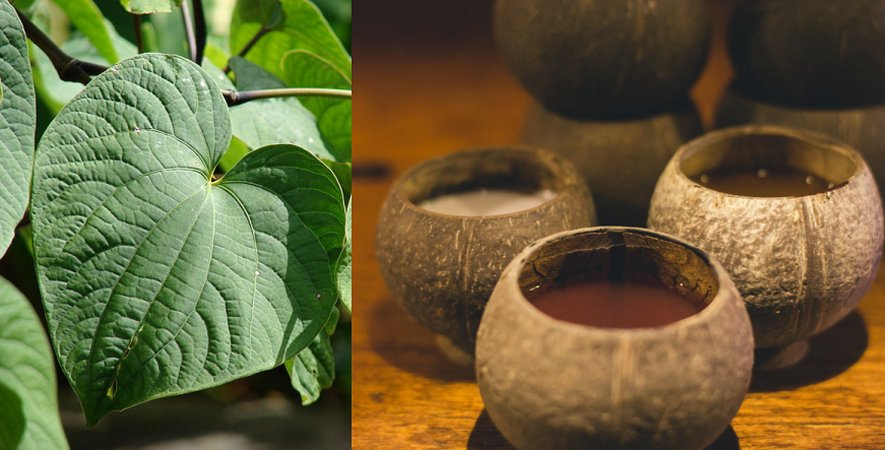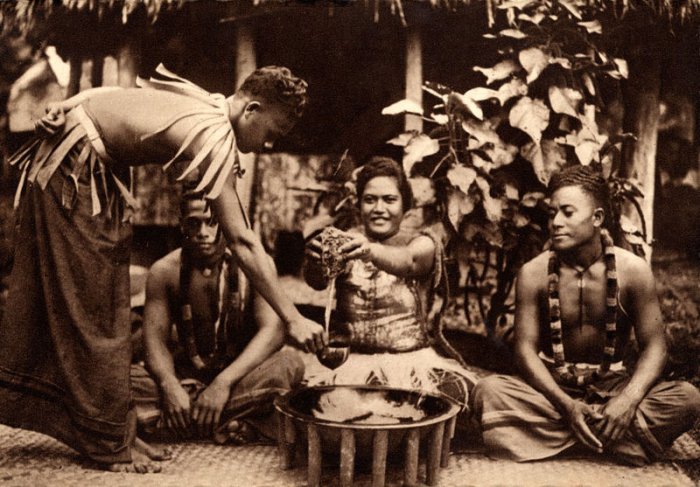Kava – Astonishing Ancient Plant That Improves Emotional Intelligence Is Gaining Popularity In The Western World
Conny Waters - AncientPages.com - Kava is an ancient plant that has been used by our ancestors for a very long time. Named after explorer Captain James Cook who encountered the herb on one of his journeys to the Pacific, Kava has been enjoyed long before written history.
Ancient people used the herb to reach a higher level of consciousness and improve their health. In the South Pacific it has been a ritual and celebratory beverage for thousands of years.
Left: Piper methysticum leaves. Credit: Public Domain - Right: Kava drink. Credit: Chronic Town USA
Modern scientists are now investigating whether the ancient plant is dangerous, but everything seems to indicate Kava is a good herb that eases anxiety, improves mood and concentration, calms the nerves, and on top of everything has an astonishing effect on emotional intelligence.
Peter Salovey and John D. Mayer coined the term ’emotional intelligence’ in 1990 describing it as “a form of social intelligence that involves the ability to monitor one’s own and others’ feelings and emotions, to discriminate among them, and to use this information to guide one’s thinking and action”.
Where Does Kava Come From?
Kava, as a drink is made from a root of a pepper plant called Piper methysticum. The plant is also known by the names Ava, Ava Pepper, Intoxicating Pepper, Kawa Awa, Kawa Kawa, Wati, Yogona, and Waka.
Samoan 'ava ceremony, c. 1900-1930. Credit: University of California Digital Libraries
The origin of the plant has been long debated. Oceanic cultures have an oral rather than written history and finding out where the plant first appeared hasn’t been easy. However, most botanists believe that Kava originated from Vanuatu and was then spread throughout the rest of the Pacific by seafaring islanders.
See also:
Ancient Secrets Of Mistletoe – Sacred Celtic Plant With Magical Powers
Airmid: Irish Goddess Of Healing And Herbs And One Of The Tuatha Dé Danann
The Ebers Papyrus – Most Famous Plant Medicine ‘Encyclopedia’ Of Ancient Egypt
Preserving Ancient Knowledge Of Kava
There is no doubt that Kava was familiar to Oceanic cultures long before Captain Cook discovered this area of the world in the late 1700’s. When Christian missionaries learned about the plant they tried to stop the use of it. Christians argued that Kava’s mind and heart-expanding properties were similar to alcohol. Still, unlike alcohol, Kava is non-addictive, non-inflammatory, and does not affect blood sugar levels. Despite the warnings from Christian missionaries, locals continued to enjoy their Kava and they still do it today. Kava plays a significant role in social gatherings in the South Pacific.
A painting showing women preparing kava. Credit: John LaFarge, Wikipedia
It is consumed at events such as weddings, funerals, naming, and healing ceremonies with the express purpose of bringing people together. Once a group of people drink Kava, it is accepted that they are one.
Kava should not be confused with Ayahuasca, a potent hallucinogenic brew used by Amazonian indigenous groups for centuries. Modern scientists have discovered that Ayahuasca can be used for healing purposes and treatment of eating disorders, but Kava has different benefits.
Whether the plant is good or bad for health is still a subject of debate, but recently there has been a renewed focus on the use of Kava and the herb is gaining popularity in the Western world.
What we should keep in mind is that there could many benefits of ancient herbal medicine that we are still unaware off.
Written by Conny Waters – AncientPages.com Staff Writer
Copyright © AncientPages.com All rights reserved. This material may not be published, broadcast, rewritten or redistributed in whole or part without the express written permission of AncientPages.com
More From Ancient Pages
-
 Eriu: Powerful Irish Goddess And Sacred Uisneach Hill Where She And God Lugh Are Buried
Celtic Mythology | Feb 15, 2019
Eriu: Powerful Irish Goddess And Sacred Uisneach Hill Where She And God Lugh Are Buried
Celtic Mythology | Feb 15, 2019 -
 Viking Age Shields From The Gokstad Ship Burial – Re-Examined
Archaeology | Apr 6, 2023
Viking Age Shields From The Gokstad Ship Burial – Re-Examined
Archaeology | Apr 6, 2023 -
 Curious Alien-Looking Slit Gongs Figures From Vanuatu Allowed Villagers To Communicate
Ancient Traditions And Customs | Sep 24, 2018
Curious Alien-Looking Slit Gongs Figures From Vanuatu Allowed Villagers To Communicate
Ancient Traditions And Customs | Sep 24, 2018 -
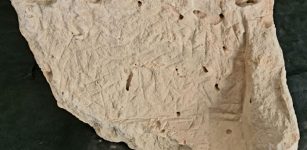 3,500-Year-Old Stone Inscribed With A Curse Against The City’s Governor Discovered In Jerusalem
Archaeology | Jul 13, 2022
3,500-Year-Old Stone Inscribed With A Curse Against The City’s Governor Discovered In Jerusalem
Archaeology | Jul 13, 2022 -
 Vikings Brewed Beer With Heated Stones – Old Tradition Popular In Germany, Finland And Baltic States
Archaeology | Dec 14, 2017
Vikings Brewed Beer With Heated Stones – Old Tradition Popular In Germany, Finland And Baltic States
Archaeology | Dec 14, 2017 -
 Ancient Secrets Of Mistletoe – Sacred Celtic Plant With Magical Powers
Ancient Traditions And Customs | Dec 17, 2024
Ancient Secrets Of Mistletoe – Sacred Celtic Plant With Magical Powers
Ancient Traditions And Customs | Dec 17, 2024 -
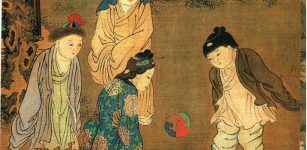 Ancient Chinese Ball Game Cuju Is Earliest Form Of Football
Ancient History Facts | Jan 22, 2016
Ancient Chinese Ball Game Cuju Is Earliest Form Of Football
Ancient History Facts | Jan 22, 2016 -
 Adorable Village Of The Little People In Connecticut
Featured Stories | Jul 25, 2019
Adorable Village Of The Little People In Connecticut
Featured Stories | Jul 25, 2019 -
 On This Day In History: Spanish Villasur Expedition Wiped Out By Pawnee And Otoe Warriors – On August 14, 1720
News | Aug 14, 2016
On This Day In History: Spanish Villasur Expedition Wiped Out By Pawnee And Otoe Warriors – On August 14, 1720
News | Aug 14, 2016 -
 Huginn and Muninn: Powerful Ravens Of Odin, Supreme God In Asgard In Norse Mythology
Featured Stories | Dec 7, 2017
Huginn and Muninn: Powerful Ravens Of Odin, Supreme God In Asgard In Norse Mythology
Featured Stories | Dec 7, 2017 -
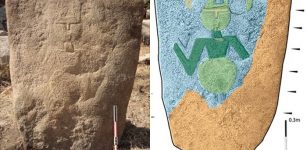 Unique Balchiria Stelae Engraved With A Goat-Like Figure Found On Corsica Is A Puzzle
Featured Stories | Feb 3, 2020
Unique Balchiria Stelae Engraved With A Goat-Like Figure Found On Corsica Is A Puzzle
Featured Stories | Feb 3, 2020 -
 Dangerous Underground Secret In The Valley No-One Dares To Enter
Featured Stories | Jun 26, 2018
Dangerous Underground Secret In The Valley No-One Dares To Enter
Featured Stories | Jun 26, 2018 -
 On This Day In History: King James I Of Scotland Was Assassinated – On Feb 21, 1437
News | Feb 21, 2017
On This Day In History: King James I Of Scotland Was Assassinated – On Feb 21, 1437
News | Feb 21, 2017 -
 Book Of Kells: Illuminated Medieval Manuscript From Monastery On Iona, Scotland
Artifacts | Feb 8, 2018
Book Of Kells: Illuminated Medieval Manuscript From Monastery On Iona, Scotland
Artifacts | Feb 8, 2018 -
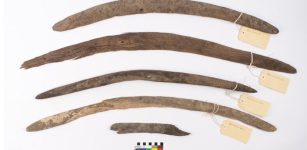 Rare Ancient Boomerang Collection Sheds New Light On Australia’s Past
Archaeology | Nov 4, 2021
Rare Ancient Boomerang Collection Sheds New Light On Australia’s Past
Archaeology | Nov 4, 2021 -
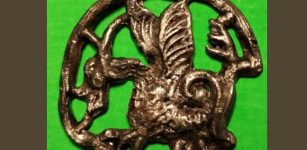 Medieval Pilgrim’s Badge (‘Pilgrim’s Sign’) Depicting A Basilisk Dragon In A Circle Discovered In Southeastern Poland
Artifacts | Mar 5, 2024
Medieval Pilgrim’s Badge (‘Pilgrim’s Sign’) Depicting A Basilisk Dragon In A Circle Discovered In Southeastern Poland
Artifacts | Mar 5, 2024 -
 Weapons Of Ancient Aztec Warriors Of Mesoamerica
Featured Stories | Mar 23, 2017
Weapons Of Ancient Aztec Warriors Of Mesoamerica
Featured Stories | Mar 23, 2017 -
 Satellite Images Reveal A Mysterious Ancient Site On A Remote Island Is Much Larger Than Previously Thought, Prompting New Questions
Archaeology | Nov 28, 2024
Satellite Images Reveal A Mysterious Ancient Site On A Remote Island Is Much Larger Than Previously Thought, Prompting New Questions
Archaeology | Nov 28, 2024 -
 Jizo – Protector Of Children, Travelers And Women In Japanese Mythology
Featured Stories | Dec 23, 2015
Jizo – Protector Of Children, Travelers And Women In Japanese Mythology
Featured Stories | Dec 23, 2015 -
 Hellenistic Decorated Tombs And Tombstone Probably Used As A False Door Unearthed In Egypt
Archaeology | Jan 10, 2018
Hellenistic Decorated Tombs And Tombstone Probably Used As A False Door Unearthed In Egypt
Archaeology | Jan 10, 2018

